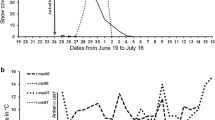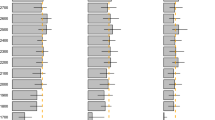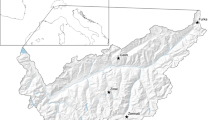Abstract
Previous work has shown that High Arctic waders in Greenland are “income breeders”, i.e. the resources used for egg formation are based almost entirely on biomass obtained on the breeding grounds. Thus, their breeding phenology is expected to be highly sensitive to inter-annual variation in food abundance during the pre-laying period. Early spring snow-cover may also influence timing of egg-laying either directly or mediated through food resources. Here, we report on the inter-annual variation in clutch initiation of three wader species breeding in High Arctic Greenland, Sanderling (Calidris alba), Dunlin (Calidris alpina) and Ruddy Turnstone (Arenaria interpres), in relation to spring snow-cover and spring arthropod abundance over ten breeding seasons at Zackenberg Research Station 1995–2005. Food abundance had the strongest effect on timing of clutch initiation, while the proportion of snow-free land had a weaker but still significant effect, i.e. more food and more snow-free land both result in earlier egg-laying. We hypothesize that food is most important when there is sufficient snow-free land to nest on, while snow-cover is of increasing importance in years with late snowmelt.


Similar content being viewed by others
References
Byrkjedal I (1980) Nest predation in relation to snow-cover—a possible factor influencing the start of breeding in shorebirds. Ornis Scand 11:249–252
Green GH, Greenwood JJD, Lloyd CS (1977) The influence of snow conditions on the date of breeding of wading birds in north-east Greenland. J Zool Lond 183:311–328
Hodkinson ID, Coulson SJ, Webb NR, Block W, Strathdee AT, Bale JS, Worland MR (1996) Temperature and the biomass of flying midges (Diptera: Chironomidae) in the high Arctic. Oikos 75:241–248
Högstedt G (1974) Length of the pre-laying period in the Lapwing Vanellus vanellus L. in relation to its food resources. Ornis Scand 5:1–4
Kattsov VM, Källén E, Cattle H, Christensen J, Drange H, Hanssen-Bauer I, Jóhannesen T, Karol I, Räisänen J, Svensson G, Vavulin S, Chen D, Polyakov I, Rinke A (2005) Future climate change: modeling and scenarios for the Arctic. Arctic Climate Impact Assessment, chapter 4. Cambridge University Press, Cambridge, pp 99–150
Klaassen M, Lindström Å, Meltofte H, Piersma T (2001) Arctic waders are not capital breeders. Nature 413:794
Meijer T, Drent R (1999) Re-examination of the capital and income dichotomy in breeding birds. Ibis 141:399–414
Meltofte H (1976) Ornithological observations in Southern Peary Land, North Greenland, 1973. Meddr Grønland 205(1):1–57
Meltofte H (1985) Populations and breeding schedules of waders, Charadrii, in high arctic Greenland. Meddr Grønland Biosci 16:1–43
Meltofte H (2000) Birds. In: Caning K, Rasch M (eds) Zackenberg ecological research operations, 5th Annual Report, 1999. Danish Polar Center, Ministry of Research and Information Technology, pp 32–39
Meltofte H (2001) Wader population censuses in the Arctic: getting the timing right. Arctic 54:367–376
Meltofte H (2003) Zackenberg basic: the biobasis programme. In: Caning K, Rasch M (eds) Zackenberg ecological research operations, 7th Annual Report, 2001. Danish Polar Center, Ministry of Science, Technology and Innovation, pp 22–51
Meltofte H (2005) Zackenberg basic: the biobasis programme. In: Rasch M, Caning K (eds.) Zackenberg ecological research operations, 10th Annual Report, 2004. Danish Polar Center, Ministry of Science, Technology and Innovation, pp 34–57
Meltofte H (2006) Wader populations at Zackenberg, high-arctic Northeast Greenland, 1996–2005. Dansk Orn Foren Tidsskr 100:16–28
Meltofte H, Berg TB (2004) Zackenberg ecological research operations. BioBasis: Conceptual design and sampling procedures of the biological programme of Zackenberg Basic. 7th edition. National Environmental Research Institute, Department of Arctic Environment http://www.dmu.dk/1_Viden/2_Miljoe-tilstand/3_natur/biobasis/biobasismanual.htm
Meltofte H, Elander M, Hjort C (1981) Ornithological observations in Northeast Greenland between 74°30′ and 76°00′ N.lat., 1976. Meddr Grønland Biosci 3:1–52
Morrison RIG, Hobson KA (2004) Use of body stores in shorebirds after arrival on High Arctic breeding grounds. Auk 121:333–344
Nettleship DN (1973) Breeding ecology of Turnstones Arenaria interpres at Hazen Camp, Ellesmere Island, N.W.T. Ibis 115:202–217
Nettleship DN (1974) The breeding of the knot Calidris canutus at Hazen Camp, Ellesmere Island, N.W.T. Polarforschung 44:8–26
Nol E, Blanken MS, Flynn L (1997) Sources of variation in clutch size, egg size and clutch completition dates of Semipalmated Plovers in Churchill, Manitoba. Condor 99:389–396
Quinn GP, Keough MJ (2002) Experimental design and data analysis for biologists. Cambridge University Press, Cambridge
Rosenberg NT, Christensen NH, Gensbøl B (1970) Bird observations in Northeast Greenland. Meddr Grønland 191(3):1–87
Roudybush TE, Grau CR, Peterson MR, Ainley DG, Hirsch KV, Gilman AP, Patten SM (1979) Yolk formation in some charadriiform birds. Condor 81:293–298
Sandercock BK, Lank DB, Cooke F (1999) Seasonal declines in the fecundity of arctic-breeding sandpipers: different tactics in two species with an invariant clutch size. J Avian Biol 30:460–468
Schekkerman H, Tulp I, Calf KM, de Leeuw JJ (2004) Studies on breeding shorebirds at Medusa Bay, Taimyr, in summer 2002. Alterra report 922, Wageningen
Sigsgaard C, Petersen D, Grøndahl L, Thorsøe K, Meltofte H, Hinkler J, Friborg T, Hansen BU, Tamstorf MP (2005) Zackenberg basic: the climatebasis and geobasis programmes. In: Rasch M, Caning K (eds.) Zackenberg ecological research operations, 10th Annual Report, 2004. Danish Polar Center, Ministry of Science, Technology and Innovation, Copenhagen, pp 10–33
Acknowledgments
We thank the Danish Polar Center for access and accommodation at the Zackenberg Research Station, and the Danish Environmental Protection Agency for financing the monitoring during all the years. MCF and TTH were supported by a grant from the Ministry of Science, Technology and Innovation. Ingrid Tulp and Hans Schekkerman kindly criticized an earlier draft of the manuscript.
Author information
Authors and Affiliations
Corresponding author
Rights and permissions
About this article
Cite this article
Meltofte, H., Høye, T.T., Schmidt, N.M. et al. Differences in food abundance cause inter-annual variation in the breeding phenology of High Arctic waders. Polar Biol 30, 601–606 (2007). https://doi.org/10.1007/s00300-006-0219-1
Received:
Revised:
Accepted:
Published:
Issue Date:
DOI: https://doi.org/10.1007/s00300-006-0219-1




